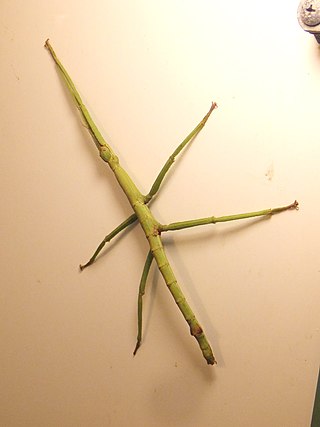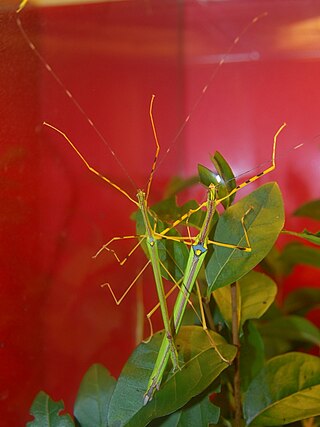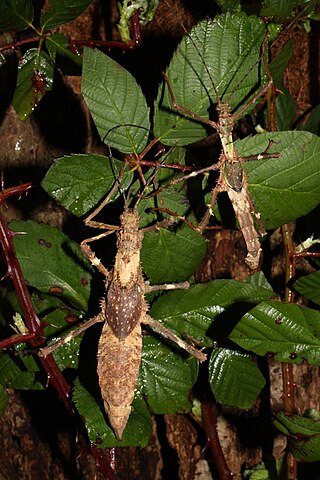
Phobaeticus serratipes is a species of stick insect that at one time was the longest known insect, with one female specimen recorded as being 55.5 cm (21.9 in) in total length. This measurement includes the legs fully extended front and rear, and the actual length of the body alone is considerably shorter. This insect is endemic to Peninsular Malaysia, Singapore and Sumatra. It is a popular species among those who raise insects.

Pharnaciini is a tribe of Asian stick insects, which includes the world's longest insects.

Necrosciinae is a subfamily of the stick insect family Lonchodidae, with its greatest diversity in South-East Asia.

Pharnacia is a tropical Asian genus of stick insects in the family Phasmatidae and subfamily Clitumninae. Some species formerly placed in this genus have been reassigned to Phobaeticus.

Sipyloidea is a genus of stick insects of the family Lonchodidae. Species have been recorded from India, China, Indochina, through to Australasia. The genus was described by Brunner von Wattenwyl in 1893.

Aschiphasmatidae are a family of stick insects belonging to the suborder Verophasmatodea; they can be found in Indomalaya.

The Heteropterygidae is a family of stick insects belonging to the suborder Euphasmatodea. Species can be found in Australasia, East and Southeast Asia. More than 130 valid species have been described.
Dajaca is a genus of stick insects belonging to the suborder Verophasmatodea, family Aschiphasmatidae and is the only representative of the monotypic tribe Dajacini. Species have been recorded from Borneo, Vietnam, Hong Kong and Myanmar.

Necroscia is an Asian genus of stick insects in the family Lonchodidae and tribe Necrosciini. Species have been recorded from South-East Asia.

The Clitumninae are a sub-family of stick insects in the family Phasmatidae found in Asia. The type genus Clitumnus is now considered a synonym of Ramulus.

The Lonchodinae are a subfamily of stick insects in the family Lonchodidae found in: Australasia, Asia, Africa, Southern America and the Pacific.
Tirachoidea is an Asian genus of stick insects in the family Phasmatidae and tribe Pharnaciini. Species have a known distribution from India, Indochina and West Malesia.

The Gratidiini are a tribe of stick insects based on the type genus Clonaria and first used by Cliquennois in 2005. Genera are known to be distributed in: Africa, Europe, temperate and tropical Asia and various Pacific Islands.

The Platycraninae are an anareolate subfamily of stick insects in the family Phasmatidae. Their known distribution includes southern, southeast Asia and Australasia.

The Obriminae are the most species-rich subfamily of the Phasmatodea family Heteropterygidae native to Southeast Asia. It is divided into two tribe.
Acacus is a genus of phasmids belonging to the tribe Necrosciini.

Heteropterygini is the only tribe within the subfamily of the Heteropteryginae. With 19 representatives described, this subfamily includes the fewest species of the three subfamilies, but includes the largest and most striking species of the family.

The Obrimini are the most species-rich tribe of the Phasmatodea family of the Heteropterygidae native to Southeast Asia.

Haaniella is a genus of the Phasmatodea family Heteropterygidae from Southeast Asia.

The Cladomorphinae are a subfamily of stick insects in the family Phasmatidae. This taxon is particularly well represented in the Neotropical region, but records also exist for Madagascar, Java and the Maluku Islands.
















